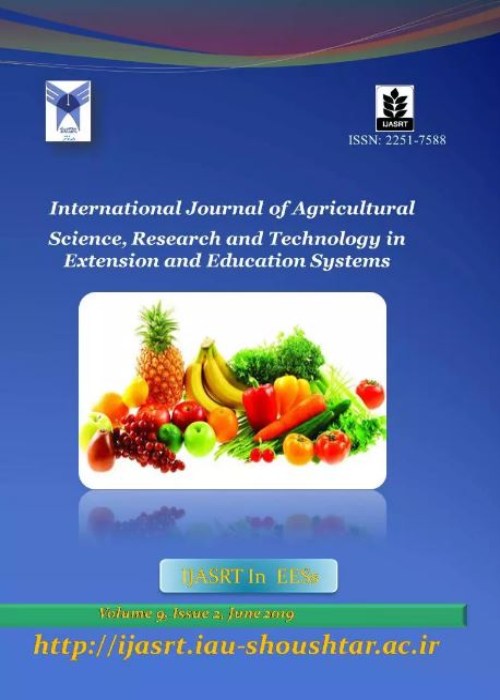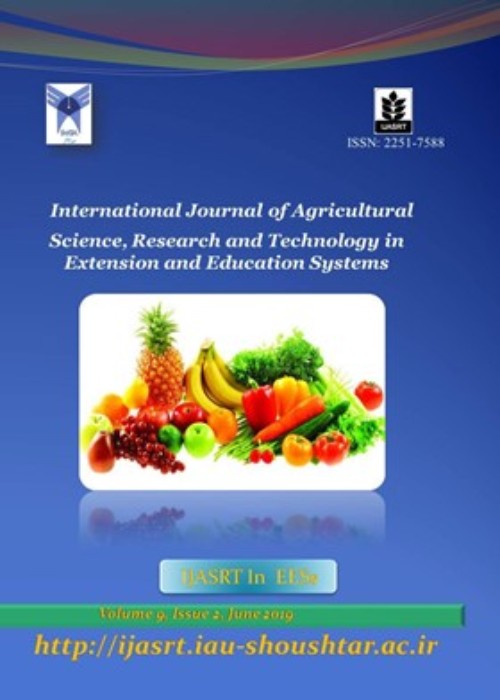فهرست مطالب

International Journal of Agricultural Science Research and Technology in Extension and Education Systems
Volume:13 Issue: 1, Mar 2023
- تاریخ انتشار: 1402/01/11
- تعداد عناوین: 6
-
Pages 1-9This study assessed the livelihood status and vulnerability context of Bangladeshi coastal small-scale fishing communities to the impacts of climate variability and change. The study was carried out in two villages of Patharghata upazilla in Barguna District, Bangladesh and data were collected from a purposively drawn sample of 90 fisher’s households. Following a mixed-method approach the data were collected using household questionnaires, key informant interviews as well as from secondary sources. A conceptual framework known as Sustainable Livelihood Approach (SLA) were used for vulnerability assessment. Most of the fishermen belong to young aged group and their educational and training status was very low. Ownership of different livelihood assets among fishermen were not satisfactory. The fishing households is more exposed to climatic variability and change that promoted the impacts of sea level rise, land erosion, cyclones and associated flooding which influence all the livelihood assets and strategies of fishing communities. Most of the households have lower access to sanitation, market transportation, health facilities, GO and NGO services during adverse climatic situation. Increased levels of cyclones and floods will result in greater damage of fishing equipment’s, livelihood assets and lower level of fish catch. Income from fisheries related activities were found reduced by reduction in fish catching which in turn affecting their livelihoods. About 51.67 percent of the sampled households were highly vulnerable i.e., they have greater probability to fall in future income vulnerability. This study recommends for similar studies in other parts of country to develop a benchmark for comparison.Keywords: Fishing community, Livelihood, Climate Change, Vulnerability, coastal Bangladesh
-
Profitability and Technical Efficiency of Maize-Based Cropping System Farmers in Ondo State, NigeriaPages 11-22This study was carried out to evaluate the technical efficiency of maize-based cropping systems in Ondo State, Nigeria. Primary data were used with the aid of a well-designed questionnaire. A multistage sampling procedure was used to randomly select 160 respondents. The data collected were analyzed using descriptive statistics, budgeting technique, and stochastic frontier production function model. The results of the budgetary technique revealed that the average gross margin per hectare was ₦17,715.03, ₦53,230.76, and ₦14,651 for sole maize cropping system, maize-cassava cropping system, and maize-yam cropping system, respectively. It was shown that household size and access to credit were the main determinants of the technical efficiency in sole maize cropping pattern, while access to credit and farming experience were the main determinants of technical efficiency in maize-cassava. In maize-yam, educational level and household size significantly affected technical efficiency. Farmers in the study area were producing at about 76% efficiency in sole maize cropping system, 89% efficiency in maize-cassava cropping system, 82% efficiency in maize-yam cropping system. The elasticity of variables inputs was 0.18 in sole maize cropping system, 0.61 in maize-cassava cropping system, and 0.33 in maize-yam cropping system. This indicates that all the maize-based cropping system had decreasing return to scale; therefore, the cropping systems fell within the rational stage of production surface. The implication is that maize-based farmers have not attained maximum efficiency in term of their production. Therefore, policy attention should be directed towards appropriate production technique that would improve productivity in the study area.Keywords: Cropping systems, Maize, Productivity, Technical efficiency
-
Pages 23-33
This research aims to investigate the role of personalized digital extension services on agricultural performance (a case study of farmers in Fars province). In terms of the purpose of an applied research and based on the nature of the research data, it is considered a descriptive-survey research. The statistical population of this research included 287,863 farmers in Fars province. Morgan's table was used to calculate the sample size. According to this table, the sample size under investigation is 385 people. A panel of experts was used to determine the validity of the questionnaire and Cronbach's alpha test was used to calculate the reliability of the questionnaire. Its value for the whole questionnaire was 898, which shows that the questionnaire has good reliability. To analyze the research data in the descriptive statistics section of the mean, median, frequency and frequency percentage and in the inferential statistics section of the structural equation modeling method with the partial least squares approach (PLS SEM) in the three main sections of external model evaluation (examining the relationship between the question and the variable), the internal model (examining the relationship between the variables) and checking the fit of the model using SPSS 21 and Smart PLS 2 statistical software. The results of the research showed that personalized digital extension services have a positive and significant effect on agricultural performance, agricultural income, variety of product production, intensity of input consumption, product productivity, willingness to use technology and product commercialization of farmers in Fars province.
Keywords: Personalized digital extension services, Agricultural performance, Income, Commercialization -
Pages 35-43Due to various policies measures to curtail the virus, one of which was lockdown, the occurrence of COVID-19 had a negative impact on the nation's economy, especially the rural smallholder farmers. The study looked into how Covid-19 lockdowns affected Nigerian vegetable production. Descriptive statistics, budgetary approaches, multiple regression analysis, and a Likert scale were all used for the analysis. The findings show that most of vegetable growers in the research region were married women (88.33%). About 70% of respondents have completed at least their primary education. The multiple regression analysis results disclosed that number of extensions contact, farm size, market access and transportation cost were significantly affected the level of vegetable production with positive sign while household size had a negative effect on the vegetable production. The findings also showed that after the COVID-19 lockdown, vegetable production was extremely profitable in the study area, with an average gross margin of 82,836.04 that was statistically higher than the 60,709.97 gross margin generated from vegetable production during COVID-19 and the 71,234.91 gross margin generated prior to COVID-19. The constraints faced by vegetable farmers during the covid – 19 restrictions include: high cost of transportation, price fluctuation, and high cost of input, perishability of the produce and lack of improved seeds. It was concluded that Covid 19 pandemic has greater effect on vegetable production in the study areasKeywords: covid 19, Lockdown, Vegetable, Gross Margin, Profitable
-
Pages 45-54The study investigated the rice post-harvest value addition competencies of Agricultural Extension Agents by the utilising the Borich Needs Assessment Model. The specific objectives sought to assess the personal characteristics of the agents, followed by their required training needs in rice post-harvest value addition. The study was done in the Southern Region of Sierra Leone which covers Bo, Bonthe, Moyamaba, and Pujehun districts. A descriptive quantitative research design that involved a survey method through a census of fifty Agricultural Extension Agents was used. Primary data were collected with a questionnaire from this population. The training needs of the agents that are required in rice post-harvest value addition technologies were analysed using the Mean Weighted Discrepancy Score (MWDS) formula of the Borich Needs Assessment model. The results were ranked and presented in tables. The results showed that the majority of the agents (84.0%) are males. Technologies such as milling paddy (MWDS=7.2769), and packaging and marketing of rice (MWDS=6.8672) ranked as the highest training needs of the agents. The study recommends an increase in the recruitment of female Agricultural Extension Agents and the provision of rice post-harvest value addition resources to improve rice quality after harvest.Keywords: Agricultural Extension Agents, rice post-harvest value addition technologies, Sierra Leone, Southern Region, training needs
-
Pages 55-64This study sought to investigate the awareness of food nutritive value and eating behaviors among peri-urban vegetable farmers in Southeastern Nigeria. The study adopted a cross-sectional descriptive survey design. A sample of 300 vegetable farmers took part in the study. Means and t tests were employed for data analysis. Results showed that peri-urban vegetable farmers were aware that nutrients are transported to cells in the body by water, water supports the removal of waste materials from the body, water helps to maintain stable internal body temperature and so on, but were unaware that fat and oils provides energy for the body, blood sugar levels can be raised by carbohydrates, and that production of insulin is supported by glucose. Eating practices commonly adopted included skipping breakfast, eating in between meals, and buying snacks as lunch, among others. There were no significant differences between male and female vegetable farmers in mean responses on food nutritive value or in eating practices adopted. Good eating habits will help farmers not only to improve their nutritional well-being, but also to prevent nutrition-related diseases. The implications for extension services and rural education are discussed in the context of these findings.Keywords: Smallholders, Agricultural extension, Farming, teaching


